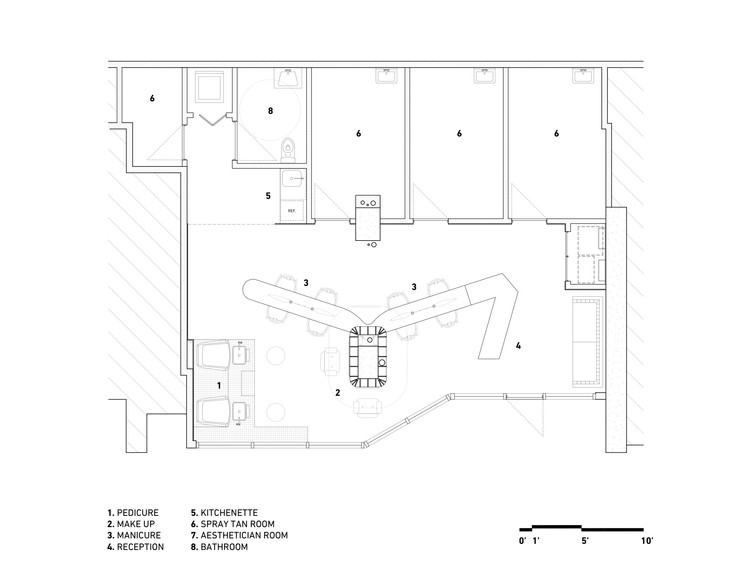Stoneridge In Situ Studio
2012-12-18 00:00
架构师提供的文本描述。我们的客户与我们进行了实质性的翻新,并对教堂山以北的现有甲板大厦进行了扩建。原来的房子是1986年的一座60年代的甲板屋的复制品。当我们的客户来找我们时,他们还没有买下那套房子。我们的第一项努力是帮助他们想象改善房子的潜力。经过一次成功的可行性研究后,他们于2010年12月购买了这套房子。
Text description provided by the architects. Our clients approached us to substantially renovate and make an addition to an existing Deck House north of Chapel Hill. The original house was a 1986 replica of a sixties-era Deck House. When our clients approached us, they had not yet purchased the property. Our first effort was to help them imagine the potential of improving the house. After a successful feasibility study, they purchased the home in December 2010.
我们的客户有一个孩子,一个经常来访的大家庭,以及一系列的兴趣,包括对听音乐和制作音乐的热爱。因此,翻修和扩建的设计必须以尽量减少“嗜好蠕变”的方式来容纳不断变化的人数和隔断活动。我们的反应是打开主客厅、厨房和餐厅的主要公共空间,巩固和组织现有的卧室区域,以容纳儿童和客人,在现有地下室提供隔离的书房和音乐区,并将一套“卫星”主套房延伸到通过玻璃大厅和屏蔽门廊连接到主房子的尽头。具有讽刺意味的是,现有的甲板楼有一个贫乏的甲板。我们的设计大大扩展了甲板和其他户外空间。
Our clients have one child, an extended family that visits often, and a range of interests, including a love of listening to and making music. The design of the renovation and addition therefore had to accommodate fluctuating numbers of people and partition activities in a manner that would minimize “hobby creep.” Our response was to peel open the primary public spaces in the main living, kitchen, and dining areas, consolidate and organize existing bedroom areas to accommodate children and guests, provide sequestered study and music areas in the existing basement, and extend a “satellite” master suite off the end of the house that is attached to the main house via a glass hall and screened porch. The existing Deck House, ironically, had an anemic deck. Our design significantly expands the deck and other outdoor spaces.
我们已经改造了房子,以适应客户,同时保持甲板楼的完整性。客厅和餐厅上方的山墙屋顶部分已经向北移动,形成了一堵两层高的玻璃墙。天窗照亮了房子的黑暗区域。主房和主套房的附加形式各不相同,它们彼此分开,以区分现有的和新的。新条目在这两种形式之间起中介作用。
We have transformed the house to suit the client, while maintaining the integrity of the Deck House. The gable roof portion of the house over the living and dining rooms has been lifted to the north, creating a two-story wall of glass. Skylights brighten darker areas of the house. The main house and the master suite addition take on different forms, and they are set apart from one another to distinguish existing from new. A new entry mediates between the two forms.
现有结构体系的逻辑是非常直接的,改造是直接从它建立起来的。主加法有一个更大胆的存在,采取矩形管的形式,悬臂从一个扩展的现有基础,并指示注意的森林北部的房子。现有的房子是以一种利用盛行的微风和捕捉自然光的方式布置的。我们的变化和增加扩大了这些功能。
The logic of the existing structural system is very direct, and the renovations build directly from it. The master addition has a bolder presence, taking the form of a rectangular tube that cantilevers off an extended existing foundation and directs attention to the forest north of the house. The existing house was sited in a manner that exploits prevailing breezes and captures natural light. Our changes and addition amplify these functions.
在今天的经济中,我们发现客户比以往任何时候都更加谨慎,更有可能进行翻新而不是拆除和重新建造。我们支持这一趋势,因为我们知道最可持续的选择集中在重用、回收和依赖现有的基础设施上。作为回应,我们对最近的几个项目进行了初步的可行性研究,从而扩大了我们的正常设计过程。我们的客户从这第一步中获得了很大的信心,他们从这一过程中获得的知识为他们与卖方和银行的谈判提供了杠杆。
In today’s economy, we are finding that clients are more cautious than ever and much more likely to renovate than demolish and build anew. We support this trend, knowing that the most sustainable choices center on reuse, recycling, and relying on existing infrastructures. In response, we have augmented our normal design process with an initial feasibility study phase on several recent projects. Our clients gain a great deal of confidence from this first step, and the knowledge they glean from the process has provided leverage in their negotiations with sellers and banks.
 举报
举报
别默默的看了,快登录帮我评论一下吧!:)
注册
登录
更多评论
相关文章
-

描边风设计中,最容易犯的8种问题分析
2018年走过了四分之一,LOGO设计趋势也清晰了LOGO设计
-

描边风设计中,最容易犯的8种问题分析
2018年走过了四分之一,LOGO设计趋势也清晰了LOGO设计
-

描边风设计中,最容易犯的8种问题分析
2018年走过了四分之一,LOGO设计趋势也清晰了LOGO设计




































































